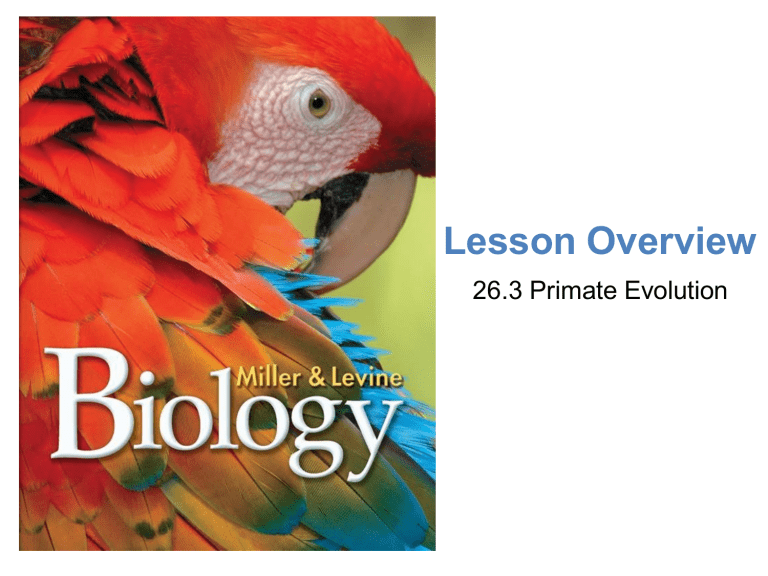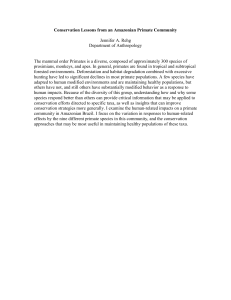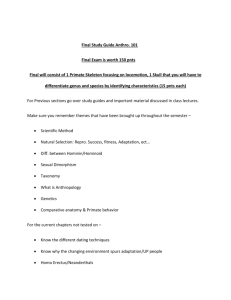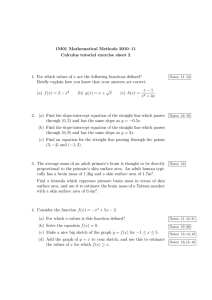
LLeessssoonnOvOveerrvvieieww PPrm i maateeEvEvoou l uto i onn Lesson Overview 26.3 Primate Evolution Lesson Overview Primate Evolution THINK ABOUT IT Primates means “first” in Latin. But what are primates “first” in? When primates appeared, there was little to distinguish them from other mammals. As primates evolved, however, several characteristics became distinctive. Lesson Overview Primate Evolution What Is a Primate? What characteristics do all primates share? Lesson Overview Primate Evolution What Is a Primate? What characteristics do all primates share? In general, a primate is a mammal that has relatively long fingers and toes with nails instead of claws, arms that can rotate around shoulder joints, a strong clavicle, binocular vision, and a well-developed cerebrum. Lesson Overview Primate Evolution What Is a Primate? Primates share several adaptations for a life spent in trees. In general, a primate is a mammal that has relatively long fingers and toes with nails instead of claws, arms that can rotate around shoulder joints, a strong clavicle, binocular vision, and a welldeveloped cerebrum. You can see most of these characteristics in a lemur. Lesson Overview Primate Evolution Fingers, Toes, and Shoulders Primates typically have five flexible fingers and toes on each hand or foot that can grip objects firmly and precisely, enabling many primates to run along tree limbs and swing from branches with ease. Lesson Overview Primate Evolution Fingers, Toes, and Shoulders Most primates have thumbs and big toes that can move against the other digits, allowing them to hold objects firmly in their hands or feet. Lesson Overview Primate Evolution Fingers, Toes, and Shoulders Primates’ arms can rotate in broad circles around a strong shoulder joint attached to a strong clavicle, or collar bone, making them well suited for climbing. Lesson Overview Primate Evolution Binocular Vision Many primates have forward-facing eyes, giving them excellent binocular vision. Binocular vision is the ability to combine visual images from both eyes, providing depth perception and a three-dimensional view of the world. This comes in handy for judging the locations of tree branches, from which many primates, like this lemur, swing. Lesson Overview Primate Evolution Well-Developed Cerebrum In primates, the “thinking” part of the brain—the cerebrum—is large and intricate, which enables more-complex behaviors than are found in many other mammals. For example, many primate species create elaborate social systems that include extended families, adoption of orphans, and even warfare between rival troops. Lesson Overview Primate Evolution Evolution of Primates What are the major evolutionary groups of primates? Lesson Overview Primate Evolution Evolution of Primates What are the major evolutionary groups of primates? Primates in one of these groups look very little like typical monkeys. This group contains the lemurs and lorises. The other group includes tarsiers and the anthropoids, the group that includes monkeys, great apes, and humans. Lesson Overview Primate Evolution Evolution of Primates Humans and other primates evolved from a common ancestor that lived more than 65 million years ago. Lesson Overview Primate Evolution Evolution of Primates: Early in their history, primates split into two groups. Lesson Overview Primate Evolution Evolution of Primates Primates in one of these groups look very little like typical monkeys. This group contains the lemurs and lorises. Lesson Overview Primate Evolution Evolution of Primates: The other group includes tarsiers and the anthropoids Lesson Overview Primate Evolution Lemurs and Lorises Lemurs and lorises are small, nocturnal primates with large eyes adapted to seeing in the dark. Many have long snouts. Living members include the bush babies of Africa, the lemurs of Madagascar, and the lorises of Asia. Lesson Overview Primate Evolution Tarsiers and Anthropoids Anthropoids, or humanlike primates, include monkeys, great apes, and humans. Lesson Overview Primate Evolution Tarsiers and Anthropoids Anthropoids split into two groups around 45 million years ago, as the continents on which they lived moved apart. Lesson Overview Primate Evolution New World Monkeys The New World monkeys are found in Central and South America. Members of this group live almost entirely in trees. They have long, flexible arms that enable them to swing from branches. New World monkeys also have a long, prehensile tail that can coil tightly enough around a branch to serve as a “fifth hand.” Lesson Overview Primate Evolution Old World Monkeys and Great Apes The other anthropoid branch, which evolved in Africa and Asia, includes the Old World monkeys and great apes. Old World monkeys spend time in trees but lack prehensile tails. Lesson Overview Primate Evolution Old World Monkeys and Great Apes Great apes, also called hominoids, include gibbons, orangutans, gorillas, chimpanzees, and humans. Recent DNA analyses confirm that, among the great apes, chimpanzees are humans’ closest relatives. Lesson Overview Primate Evolution Hominine Evolution What adaptations enabled later hominine species to walk upright? Lesson Overview Primate Evolution Hominine Evolution What adaptations enabled later hominine species to walk upright? The skull, neck, spinal column, hip bones, and leg bones of early hominine species changed shape in ways that enabled later species to walk upright. Lesson Overview Primate Evolution Hominine Evolution Between 6 and 7 million years ago, the lineage that led to humans split from the lineage that led to chimpanzees. The hominoids in the lineage that led to humans are called hominines and include modern humans and all other species more closely related to us than to chimpanzees. Lesson Overview Primate Evolution Hominine Evolution Hominines evolved the ability to walk upright, grasping thumbs, and large brains. The skull, neck, spinal column, hip bones, and leg bones of early hominine species changed shape in ways that enabled later species to walk upright. Lesson Overview Primate Evolution Hominine Evolution This figure shows some ways in which the skeletons of modern humans differ from those of hominoids such as gorillas. Lesson Overview Primate Evolution Hominine Evolution The evolution of bipedal, or two-footed, locomotion was very important, because it freed both hands to use tools. The hominine hand evolved an opposable thumb that could touch the tips of the fingers, enabling the grasping of objects and the use of tools. Lesson Overview Primate Evolution Hominine Evolution Hominines evolved much larger brains. Most of the difference in brain size results from an expanded cerebrum, which is, as you recall, the “thinking” part of the brain. Lesson Overview Primate Evolution New Findings and New Questions The study of human ancestors is exciting and constantly changing. Recent discoveries in Africa have doubled the number of known hominine species and the length of the known hominine fossil record. These data have enhanced the picture of our species’ past, but questions still remain as to how fossil hominines are related to one another—and to humans. Lesson Overview Primate Evolution Relatives Versus Ancestors The hominine fossil record includes seven genera—Sahelanthropus, Orrorin, Ardipithecus, Australopithecus, Paranthropus, Kenyanthropus, and Homo—and at least 20 species. All these species are relatives of modern humans, but not all of them are human ancestors. Lesson Overview Primate Evolution Relatives Versus Ancestors Lesson Overview Primate Evolution The Oldest Hominine? In 2002, paleontologists in Africa discovered a fossil skull roughly 7 million years old. This fossil, called Sahelanthropus, is a million years older than any known hominine. Lesson Overview Primate Evolution The Oldest Hominine? Sahelanthropus had a brain about the size of a modern chimp, but its short, broad face was more like that of a human. Scientists are still debating whether this fossil represents a hominine. Lesson Overview Primate Evolution Australopithecus Hominines of the genus Australopithecus lived from about 4 million to about 1.5 million years ago. Australopithecus afarensis fossils are shown. These hominines were bipedal apes, but their skeletons suggest that they probably spent some time in trees. The structure of their teeth suggests a diet rich in fruit. Lesson Overview Primate Evolution Australopithecus Australopithecus afarensis fossils indicate the species had small brains. Excavations have found fossilized humanlike footprints that were probably made by members of A. afarensis about 3.6 million years ago. Such finds show that homines walked bipedally before large brains evolved. Lesson Overview Primate Evolution Australopithecus Other A. afarensis fossils indicate that males were much larger than females. Lesson Overview Primate Evolution Lucy The best-known A. afarensis specimen is a partial skeleton of an adult female discovered in 1974, nicknamed “Lucy.” Lucy stood about 1 meter tall and lived about 3.2 million years ago. Lesson Overview Primate Evolution The Dikika Baby In 2006, an Ethiopian researcher announced the discovery of some 3.3 million-year-old fossils of a very young A. afarensis female, nicknamed “the Dikika Baby.” The skeleton included a nearly full skull and jaws, torso, spinal column, limbs, and left foot. Leg bones confirmed that the Dikika Baby walked bipedally, while her arm and shoulder bones suggest that she would have been a better climber than modern humans. Lesson Overview Primate Evolution Paranthropus The more-recent Paranthropus species had huge, grinding back teeth, and their diets probably included coarse and fibrous plant foods like those eaten by modern gorillas. Lesson Overview Primate Evolution Paleontologists place Paranthropus on a separate, dead-end branch of our family tree. Lesson Overview Primate Evolution Hominine Relationships A series of hominine adaptive radiations produced a number of species whose relationships are difficult to determine. As a result, what once looked like a simple hominine “family tree” with a single main trunk now looks more like a shrub with multiple trunks. Lesson Overview Primate Evolution The Road to Modern Humans What is the current scientific thinking about the genus Homo? Lesson Overview Primate Evolution The Road to Modern Humans What is the current scientific thinking about the genus Homo? If you look at the Hominine Time Line, you can see that many species in our genus existed before our species, Homo sapiens, appeared. Furthermore, at least three other Homo species existed at the same time as early humans. Lesson Overview Primate Evolution Many species in our genus existed before our species, Homo sapiens, appeared. Lesson Overview Primate Evolution At least three other Homo species existed at the same time as early humans. Lesson Overview Primate Evolution The Genus Homo: About 2 million years ago, a new group of hominine species appeared. Lesson Overview Primate Evolution The Genus Homo The fossils of this new group of hominine species resemble modern human bones, and so they are classified in the genus Homo. One set of fossils was found with tools made of stone and bone, so it was named Homo habilis, which means “handy man” in Latin. Lesson Overview Primate Evolution The Genus Homo The earliest fossils that researchers assign to the genus Homo belong to Homo ergaster. Lesson Overview Primate Evolution The Genus Homo H. ergaster was larger than H. habilis and had a bigger brain and downward-facing nostrils that resemble those of modern humans. Lesson Overview Primate Evolution Out of Africa—But When and Who? Researchers agree that our genus originated in Africa and migrated from there to populate the world. Some current hypotheses about when hominines first left Africa and which species made the trip are shown in the figure. Lesson Overview Primate Evolution The First to Leave Fossil and molecular evidence suggest that some hominines left Africa long before Homo sapiens evolved and that more than one Homo species made the trip in waves. Hominines began migrating out of Africa at least 1.8 million years ago. Hominine remains from that period were found in the Republic of Georgia, which is north of Turkey and far from Africa. Lesson Overview Primate Evolution Homo erectus in Asia According to some researchers, groups of Homo erectus traveled across India and through China to Southeast Asia. Some of the oldest fossils of H. erectus were uncovered on the Indonesian island of Java, suggesting that these hominines spread very rapidly once they left Africa. Lesson Overview Primate Evolution The First Homo sapiens There are two main hypotheses of how Homo sapiens arose. The multiregional model suggests that, in several parts of the world, modern humans evolved independently from widely separated populations of H. erectus. The “out-of-Africa” model proposes that modern humans evolved in Africa about 200,000 years ago, migrated through the Middle East, and replaced the descendants of earlier hominine species. Lesson Overview Primate Evolution The First Homo sapiens Recently, molecular biologists analyzed mitochondrial DNA from living humans around the world and determined they last shared a common African ancestor between 200,000 and 150,000 years ago. More recent DNA data suggest that a small subset of those African ancestors left northeastern Africa between 65,000 and 50,000 years ago to colonize the world, supporting the out-of-Africa hypothesis. Lesson Overview Primate Evolution Modern Humans The story of modern humans over the past 200,000 years involves two main species: Homo neanderthalensis and Homo sapiens. Lesson Overview Primate Evolution Homo neanderthalensis Neanderthals flourished in Europe and western Asia beginning about 200,000 years ago. Evidence suggests that they made stone tools, lived in complex social groups, had controlled use of fire, were excellent hunters, and performed simple burial rituals. Neanderthals survived in parts of Europe until about 28,000–24,000 years ago. Lesson Overview Primate Evolution Modern Homo sapiens Anatomically modern Homo sapiens arrived in the Middle East from Africa about 100,000 years ago. Lesson Overview Primate Evolution Modern Homo sapiens By about 50,000 years ago, H. sapiens populations, including some now known as Cro-Magnons, were using new technology to make more sophisticated stone blades and were making tools from bones and antlers. They produced spectacular cave paintings and buried their dead with elaborate rituals. Lesson Overview Primate Evolution Modern Homo sapiens Neanderthals and H. sapiens lived side by side in the Middle East for about 50,000 years. Later, both groups moved into Europe, where they coexisted for several thousand years. For the last 24,000 years, however, Homo sapiens has have been Earth’s only hominine. Why did Neanderthals disappear? Did they interbreed with H. sapiens? No one knows for sure.



